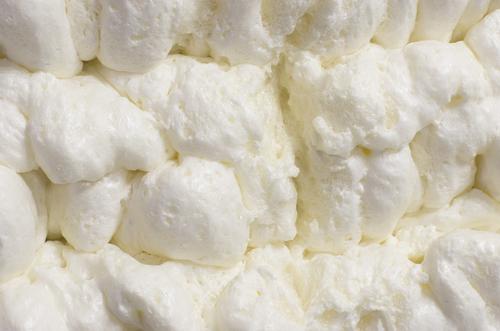There are many factors that affect the quality of polyurethane spray foam. Next, we will focus on the seven main factors that affect its quality. If you understand the following main factors, you will be able to control the quality of polyurethane spray foam very well.
1. The influence of the surface layer and the surface layer of the wall base.
If there is dust, oil, moisture and unevenness on the surface of the external wall, it will seriously affect the adhesion, insulation and flatness of the polyurethane foam to the insulation layer. Therefore, it is necessary to ensure that the wall surface is clean and flat before spraying.
2. The influence of humidity on aerosol foaming.
As the foaming agent is prone to chemical reaction with water, the content of the product increases, which tends to increase the brittleness of polyurethane foam and will seriously affect the adhesion of rigid polyurethane foam to the surface of the wall. Therefore, the exterior walls of buildings are sprayed with rigid polyurethane foam before construction, and it is best to brush a layer of moisture-proof polyurethane primer (if the walls are completely dry in summer, a step can be saved).
3. The influence of wind.
Polyurethane foaming is done outdoors. When the wind speed exceeds 5m/s, the heat loss in the foaming process is too great, the raw material loss is too great, the cost increases, and the atomised droplets are easy to fly with the wind. The pollution of the environment can be solved by windproof curtains.
4. The influence of ambient temperature and wall temperature.
The suitable temperature range for spraying polyurethane foam should be 10°C-35°C, especially the temperature of the wall surface has a great influence on the construction. When the temperature is lower than 10, the foam is easy to take off the wall and bulge, and the foam density increases significantly and wastes raw materials; when the temperature is higher than 35°C, the loss of foaming agent is too large, which will also affect the foaming effect.
5.Spraying thickness.
When spraying rigid polyurethane foam, the thickness of spraying also has a great impact on the quality and cost. When polyurethane spraying exterior wall insulation construction, the thickness of the insulation layer is not large, generally 2.03.5 cm, due to the good insulation of polyurethane foam. At this point, the thickness of the spray should not exceed 1.0 cm. Ensure that the surface of the sprayed insulation is flat. The slope can be controlled in the range of 1.0-1.5 cm. If the thickness of the aerosol is too large, the levelness will be difficult to control. If the thickness of the aerosol is too small, the density of the insulation layer will increase, wasting raw materials and increasing costs.
6. Spray distance and angle factors.
General hard foam spraying work platform is scaffolding or hanging baskets, to obtain good foam quality, the gun to maintain a certain angle and spraying distance is also important. The correct angle of the spray gun is generally controlled at 70-90, and the distance between the spray gun and the object being sprayed should be kept within 0.8-1.5m. Therefore, polyurethane spraying construction must have experienced professional construction personnel to carry out construction, otherwise it will affect the quality and increase the cost.
7.Interface treatment factor of rigid polyurethane foam insulation layer.
After spraying the rigid polyurethane foam to the required thickness, the interface treatment can be carried out after about 0.5h, i.e. brush away the polyurethane interface agent. The general interface agent should not be applied for more than 4h (can be saved when there is no sunlight). This is because after 0.5h of foaming, the strength of the rigid polyurethane foam basically reaches more than 80% of its optimum strength and the rate of change in size is less than 5%. The rigid polyurethane foam is already in a relatively stable state. and should be protected as soon as possible. Plastering of the levelling layer can be carried out after the polyurethane interface agent has been applied for 24 hours and has finally set.
It is important to pay attention to the factors affecting the quality of the polyurethane spray foam during construction and to try to avoid unnecessary losses. Customers are advised to choose a professional construction team to ensure both the construction progress and the quality of the project.
Post time: Dec-28-2022



